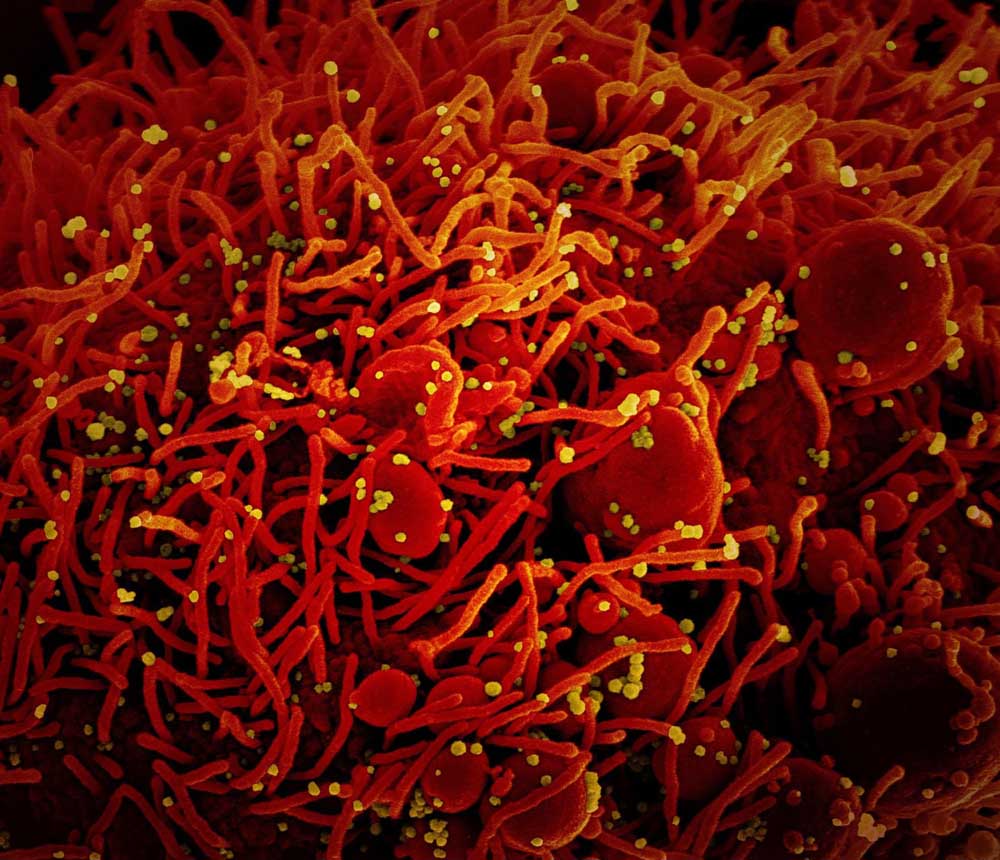Editorial: Learn from covid blunders by preparing now for other disasters
Published 1:57 pm Monday, May 18, 2020

- Cells infected with covid-19 SARS virus particles (shown in yellow). An innovative test found around 30 infected people made use of the Long Beach sewer system over the Independence Day weekend.
Anyone who thinks this pandemic was a big surprise wasn’t paying attention. A bad one was overdue and had been predicted for decades — talked and written about to such an extent that even people who pay attention had become a little jaded about it.
Viruses are constantly mutating. The vast majority of these minuscule genetic changes are meaningless. But every so often, the viral slot machine hits skull and crossbones three across. The mutations line up to make a virus especially deadly, transmissible or both. It’s our bad luck to be alive in a time when a deadly and easily spread virus came spilling out of nature’s one-armed bandit.
There’s plenty of blame to go around when it comes to lack of preparedness and the haphazard response. Regarding the federal covid fiasco, U.S. citizens get to give their verdict one way or another in November’s election. Fundamentally, however, we’re all to blame for complacency in a world that is chaotic — and which we’re making even less predictable by fooling around with Mother Nature. We’re constantly begging to get our butts kicked. It’s no wonder it finally happened.
There are dozens of ways in which judicious investment can provide jobs and income now while building future resiliency. We must advocate for them, rather than for more bailouts of ungrateful multinational corporations that too often use the money to buy back their own stock or give bonuses to executives. Now is the time to invest in real Americans.
There are still many hills and valleys to cross before we’re clear of this particular crisis, but it’s none too soon to start doing better at preparing for future disasters we know will happen. In fact, by growing up and facing future responsibilities now, we can help dig ourselves out of the perilous economic hole into which we’re toppling. It is time for a wartime-like infrastructure funding plan that will address genuine needs while putting people back to work.
A key need — for our region and for the nation as a whole — is preparing for the Cascadia subduction zone earthquake and tsunami we know will happen. Less frequent than major pandemics but still nightmarishly deadly, the next one of these cataclysmic disasters may kill tens of thousands of people in a day and cripple the national economy for a decade or more. We have barely started responding to our knowledge of this destructive certainty.
U.S. coastal residents from the Canadian border to Northern California are sitting ducks for series of tsunamis that will follow an extreme subduction quake. An intelligent investment in multipurpose vertical evacuation structures can save thousands of lives, providing accessible “high ground” in dozens of low-lying communities. Instead of wringing our hands in the aftermath, we should have a national design competition to develop long-lasting structures to be used for everything from summer parking to winter indoor recreation. Build them to last, but with enough flexibility to be recycled or renovated for changing needs. After all, the CSZ disaster may happen today, or not for another century.
This also is a good time to kick-start reinforcement of critical bridges, overpasses and other vital transportation infrastructure on the coast and a hundred miles inland. If we can be fairly certain, for example, that the Astoria-Megler Bridge will be wrecked by a quake and have to be replaced, it may be cheaper to begin systematically re-engineering it now. Same with public buildings — particularly schools and hospitals. Our peninsula missed an opportunity in 2003 when we voted to keep elementary schools in vulnerable locations. The time is ripe for federal grants and zero-interest loans to correct that mistake here and elsewhere on the coast by moving schools to higher elevations, where they can also serve as evacuation centers.
We’re all tired of hearing about climate change, but it too is a certainty. This would be an ideal time to employ local workers and companies in starting to raise critical highways that are already prone to tidal flooding. There are several in Pacific and Wahkiakum counties, and a notable example in Seaside, that would benefit. As it now stands, there are times when thousands of coastal people find it difficult to travel inland at times in the winter — a peculiar situation in a nation that so prides itself on advancement.
There are dozens of ways in which judicious investment can provide jobs and income now while building future resiliency. We must advocate for them, rather than for more bailouts of ungrateful multinational corporations that too often use the money to buy back their own stock or give bonuses to executives. Now is the time to invest in real Americans.
In closing, there is nothing in nature’s rule book that says we will only get a major new pandemic virus once per century. A year from now we could be close to beating covid-19 only to have something just as bad pop up. We as a nation must invest in good ongoing scientific research, vaccine capacity, pharmaceutical manufacturing and renewed stockpiles of essential supplies.
It’s awful being struck by a disaster; stupid and reprehensible getting smacked by one we saw coming. Let’s learn from this tragic blunder.









